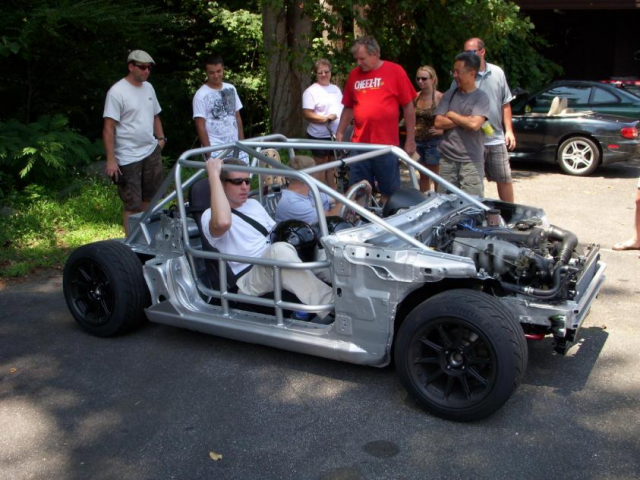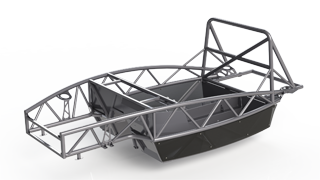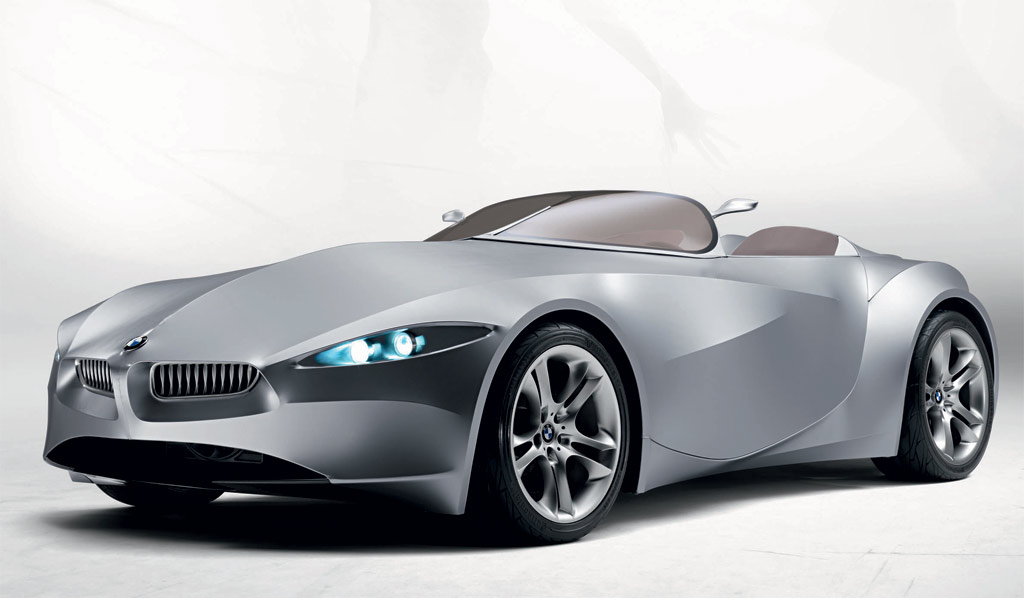
In reply to Keith Tanner:
Looks great! very similar idea to what I'm thinking (though, as pointed out, without the structure above), and I gotta believe that is both lighter and stiffer than it was from the factory.
I'm shooting for 'about as stiff' as it started. Aaaand mine will be a lot larger than that one.
Hey, they don't call it the 'challenge' for nothing, right?
In reply to Keith Tanner:
That car:
has diagonal bracing
has a roof hoop with cross bracing
is a 2 door
was originally a convertible, therefore already has a reinforced pan
You do NOT need a roof if you add some side triangulation and a roll structure. Look at Atoms, RCR Razors, Exocets, etc. One issue with square vs round may be cost. Every time I have priced tubing there is a big difference, with the square being a lot more $.
Ok, so, here's a pic to look at (shamelessly stolen from exocet website):

This car looks to have a really nice side tress setup (and admittedly the drawing I made doesn't have tresses like this, but it easily could).
It looks like there is no diagonal bracing here on either the horizontal plane (other than the sheet metal in the bottom) or the side-to-side vertical plane (again, other than the sheetmetal in the firewalls front and back) inside of the passenger compartment .
It does look like the roll hoop is extending the truss bracing to the back of the frame, but, if say the roll hoop were only half as high, how much would that really impact the front to back and 'corner weight' stiffness?
My thought remains that if you don't need functioning doors, you really can do a lot without the 'roof'.
olpro wrote: You do NOT need a roof if you add some side triangulation and a roll structure. Look at Atoms, RCR Razors, Exocets, etc. One issue with square vs round may be cost. Every time I have priced tubing there is a big difference, with the square being a lot more $.
Right.
We agree.
olpro wrote: You do NOT need a roof if you add some side triangulation and a roll structure. Look at Atoms, RCR Razors, Exocets, etc. One issue with square vs round may be cost. Every time I have priced tubing there is a big difference, with the square being a lot more $.
Yes, cost may be a big factor. I figured that metal is mainly sold by weight (ie the material is most of the cost, and that preparing it costs about the same for various shapes) but that could be very wrong.
In reply to rcutclif:
THAT works (and does have LOTS of triangulation).
Your first drawing does not.
SVreX wrote: In reply to Keith Tanner: That car: - has diagonal bracing - has a roof hoop with cross bracing - is a 2 door - was originally a convertible, therefore already has a reinforced pan
It was simply an example of the original concept, addressing the idea more than the discussions on pan design. Although one of the best things you can do for Miata rigidity is reinforce the pan ![]()
By the time the cage is welded in, the fact that it started as a convertible is rather moot. The builder is currently working on (or has finished) one based on an Evo.
In reply to Keith Tanner:
I don't disagree.
But I think you missed the part where the OP said he doesn't want to build a cage.
The pan strength is pretty significant if you are not adding a cage.
olpro wrote: You do NOT need a roof if you add some side triangulation and a roll structure. Look at Atoms, RCR Razors, Exocets, etc. One issue with square vs round may be cost. Every time I have priced tubing there is a big difference, with the square being a lot more $.
Right on the money. The thing about using tubing is that load paths must be taken into account when designing, this can be hard to visualize.
SVReX is also correct that a unibody car depends a lot on the roof for structural stiffness but it's not the only way to accomplish that. Back to the Miata for a moment: a deep drawn center tunnel combined with stiff rockers and a deep drawn 'box' section across the rear (behind the seats) put back a lot of rigidity that the missing roof would have added. You'll see the same thing in just about any 'purpose built' roadster, the Fox body Mustang convertible is a good example of a bad practice: cutting the roof off without adding proper rigidity back. I can attest to this first hand, having worked for Ford when those cars were new. They were coupes that had been sent to an outside company for conversions and were so bad that if on a asymmetric lift you couldn't open the doors.
The point: the existing 4 door car that's being cut away won't have the same design elements and thus the replacement 'exoskeleton' will need to provide that, unless you want a floppy noodle of a chassis. That will mean a roll cage, I honestly can't visualize adding the necessary stiffness back without that step.
Oh, and I vote for round tubing. Equal stiffness in all planes, cheaper than square. Tubing notchers are available from Harbor Fright and there's bound to be someone in your area with a draw or mandrel bender (don't use exhaust tubing benders, not the same thing).
By the way, in the pic that Keith posted, have you looked at the 'load paths'? The most easily visible one: follow the front members to the front roll hoop, then look at the 'V' of tubing in the cage 'halo', then see where at the rear hoop there's another 'V' which travels to the rear of the chassis. That means loads input at the front of the chassis then follow that load path to the rear and vice versa making for a stiff structure. Like a bridge truss.
Keith Tanner wrote:
This whole idea intrigues me. Does anyone know the NHRA rules regarding a car like this, my search skills are failing me.
tuna55 wrote:Appleseed wrote: Doesn't part of the rules say that most of the bodywork must be intact? Do it anyway, because its rad, but realize you may be placed in the exhibition class.I don't think the rules say that anymore, but I could be wrong. http://grassrootsmotorsports.com/events/2015-challenge-rules/
Woah...when did they remove the tube frame clause? ![]()
You could take a cue from BMW themselves, and after you build the space frame cover it with fabric.
BMW Gina:

If you ever tore apart a TR7 convertible and a coupe, you'd be amazed how little extra metal is in the convertible body. As far as I can tell, there are only 4 extra pieces, none of which weigh more than a couple of pounds. No way in the world a TR7 vert shell weighs more than a coupe shell. My guess is the TR7 was designed to be a convertible all along. It just so happened to start off only in coupe form. I just cut the roof off a TR8 coupe to build a roll cage. That sucker weighs at least 40 pounds with all the internal bracing... which is now gone and replaced with new DOM round tubes.
stuart in mn wrote: You could take a cue from BMW themselves, and after you build the space frame cover it with fabric. BMW Gina:
I have always loved that idea.
Not to mention what happens to your skull when it substitutes for a proper roll cage. I can't see tech allowing that car with no roll protection anywhere near a track.
I've seen a Chumpcar Ford Galaxie 4 door from late 60's to early 70's with the roof cut off, but it does have a professional roll cage in it. I wouldn't know why anyone would want to compete with out one.
In reply to WillrunifChased:
If the cage meets/exceeds NHRA specs, you're cool. Dunno how it would class, but I don't see one getting kicked out of grudge night or anything like that. I believe the general "it needs a cage" thing is only based on ET/trap speed and how hacked up the floor is (more of a hot rod thing).
In reply to rcutclif: Jaguar used Square tubing on the frame of the XK-E (and the "D" type) It's lighter not heavier.. In fact if anybody let's you cut up an XK-E frame you will find the frame tubing is thinner than sheet metal.. Plus it's brazed together not welded..
Yes it's massively easier to build, but it also passed crash tests with flying colors..
The real advantage is the ease of making triangles with square tubing.. as we all know a triangle is stronger than a square etc.. So look at the front frame of either an XK-E or late Trans-Am (The race car not the Pontiac) They overlap the tubing and wind up with all sorts of neat triangles..
A couple things I've picked up in fabrication that may or may not be true, but I'll mention them. If they're wrong, I'm sure someone will correct me.
With tubing (round or square), for the same weight, a larger diameter/thinner wall is stronger than smaller diameter/thick wall. (to a point). For instance if you have a 1.5" tube with 1/8" walls that weighs a certain amount per linear foot, and also have some 2" with 3/16" walls that weighs the same, the 2" is stronger.
DOM is stronger than seam welded
this one I might be misremembering: Round tube is stronger torsionally. Square tube is stronger laterally. For load bearing (like frame rails) square stuff. Round tube: For instance, those rails replacing the side body work, if they are round tube, they will prevent body twist better than square. Is that right?
There are many things to take into consideration when deciding between round, square and rectangular. Round has many good quantities. Its uniformly stiff axially, laterally and torsionally. If that is what you need its a great choice. The joints are tougher to cut and weld. You can also get "hot spots" on thin wall round tubing which will go into punching shear(think cookie cutter) at those points. Gussets in the corners can spread out the load and lessen the punching shear. Using thicker tubing at the joints can also do this but the joint won't be as stiff. It will be easier to build. Its all a compromise. Don't confuse member torsion resistance with frame torsion resistance. Any structural design has to take both member stresses, connection stresses and overall frame design strength and stiffness into account. All these "trusses" are really frames because the members are welded and transmit axial and bending forces through the joints. True trusses only transmit axial loads and have "pinned" connections. True trusses are rare even in bridge construction now-a-days. Square tubing is easier to cut and weld. It is not as stiff as round lb for lb. Look up structural properties in a steel design website. You can find weight per foot and compare other properties vs weight. I = moment of Inertia. This is a unit used to compare stiffness of a member. S = section modulus = this is to help calculate stress in a member. A structural analysis program analyses for bending, axial load, shear and torsion. Then it adds up the combined internal stresses to let you know if you are in the right place with section selection. The structural analysis procedure is to analyze the frame with the given design parameters while watching stress and deflection (stiffness). Once you have that then you design the connections - possibly beefing up material at the connections so you can keep the added lightness in between.
I can't put 4 years of engineering school into this but I am seeing ya'll going into antidotes that aren't quite correct and in some cases need to be re-thought after a little research.
And p.s. -the roof of a unibody adds beaucoup bending and torsional stiffness to the chassis. Cutting off the roof will drastically reduce the bending moment of inertia - this means orders of magnitude more deflection.
rcutclif wrote: So, I got this crazy idea for my challenge car. It would be a lot of work, but 'going big or going home' is usually how my car projects work out, and this is turning out to be no different. The idea is this: 1. Cut away a significant portion of the body panels. 2. Cut away some of the unibody. 3. Replace where necessary with steel tube. Basically try to make a 'Luxo-cet' or an 'Exo-yacht'. Pic of idea (PAD):So, the question is: Round tube or Square tube? I know round tube is easier to cut and shape (joints between tubes are much easier, mainly, and cue the jokes), but strength for strength, it is heavier. Is cost about the same between square and DOM? I would probably stay away from ERW or whatever. I also have never built a cage or locost or exo car before, so my fab skills are currently low-ish. I have welded up a fully custom exhaust with straight tubes and mandrel bends, but this would be more intricate I imagine. Part of me wanting to do this is to learn though, that is a big part of the draw.
Well it depends on the design!
I give you the Jaguar D type 1954 through the XK-E up to 1974 square tube front subframe
Full Race car? most of the Trans-Am cars built towards the end of that series..
There are some very sound engineering reasons to build with square tubes. For example much broader contact area. If you look carefully tubes overlap to form triangles rather than being edge joined as most round tube frames are.. Further if panels are used to either add strength or enclose something such as an engine bay or door sides etc.. The broader contact area allows adhesives rather then welding or riveting..
You'll need to log in to post.